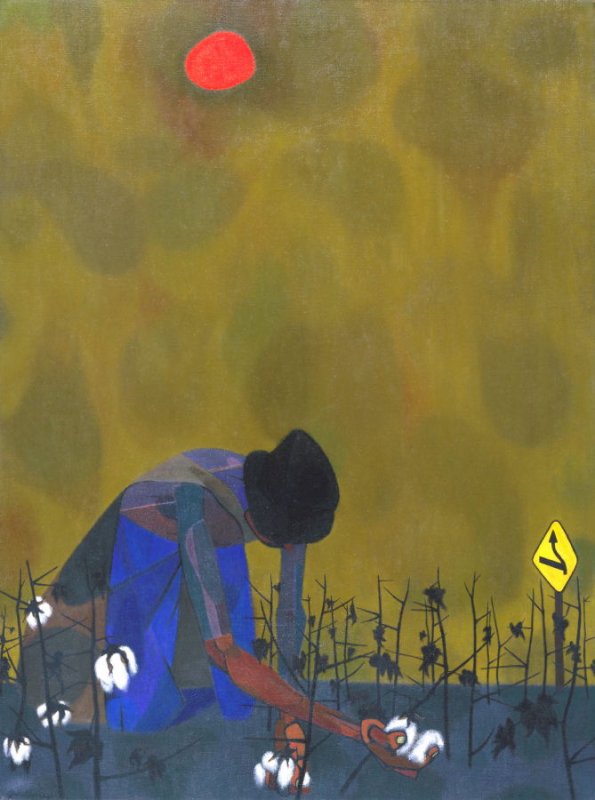 Cotton Picker, Robert Gwathney
Cotton Picker, Robert Gwathney
Robert Gwathney’s “Cotton Picker”
The red sun, enraged eyeball
sinking by its own bloody weight
through mustard gas green splotched sky
watches a big spidery brown hand touch
two white testicles of cotton
and the warped line on the yellow route sign
points straight up to nothing
amid nearly bare, needle-thorned plants
and the frail, slump-shouldered figure
in motley crawls on, face mercifully hidden
by the brim of a battered hat.
________________
Dan Liberthson
Review by Anne Evans
This ekphrastic poem describing the painting “Cotton Picker” by Robert Gwanthney intrigued me with its precise concrete descriptions of the objects. From labeling the red sun an “enraged eyeball” sinking with its own “bloody weight” to the “mustard gas green” sky, the diction and colors carry malevolent connotations and reference other historical atrocities, a fitting backdrop for the cotton picker, who reaches out for “two white testicles of cotton.” The poet’s choice of “testicle” works ambiguously here. Looking at the original painting, one can see how the image conjures male genitalia. Using the clinical term of human anatomy suggests the plant is more valued as a cash crop than the enslaved people and later economically enslaved sharecroppers who picked it. Likewise, the poet describes the human worker with animalistic imagery: the description of the “spidery brown hand,” and how it “crawls.” Thus the picker crawling on hands and knees is subjugated to being beneath the cotton boll, now elevated to this precious part of the human body, the potential site of reproduction, wealth, and lineage.
The final lines reinforce the mistreatment and depersonalization of the worker, yet, the word “mercifully” rehumanizes the picker, reminding readers it is a mercy to keep the identity hidden and anonymous within this degrading position. At the same time, both poem and painting give voice and dignity to the worker, whose plight is central to the canvas. Through the description of the sun watching as if “enraged,” the natural world protests this unjust economic system. In these ways the poem works successfully as a “poem of witness,” alerting readers to the disgrace of “man’s inhumanity to man.”
Review by Massimo Fantuzzi
Narration of a narration (the homonymous painting). All the elements are reproduced with precision and yet, and yet, like in a game of mirrors, of Chinese whispers, the writer and the painter on one side, the reader and the spectator on the other, each one tells and reads and sees their own story. The exercise/fun would be to re-write this poem, not having looked at the painting, pass it on, ask somebody else to re-write it, and so on and so on, to finally see, after six-ten passes, how far we’ve landed from the original picture.
